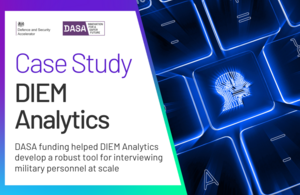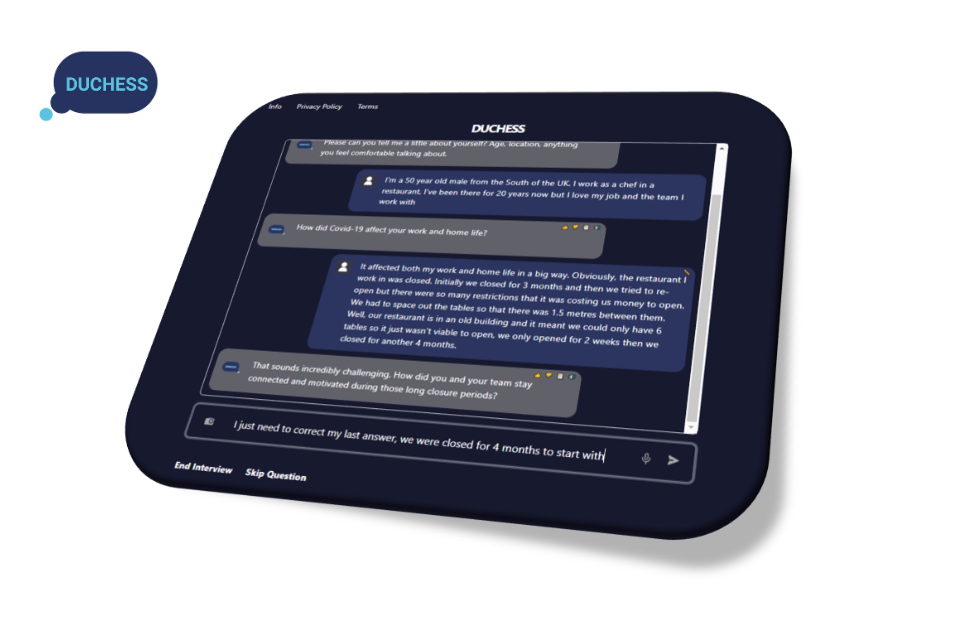DASA-Funded Tech ‘DUCHESS’ Takes the Crown in AI Interviewing
DASA funding helped DIEM Analytics develop a robust tool for interviewing military personnel at scale

- DUCHESS was developed before the generative AI boom, giving DIEM Analytics strategic advantage in the evolving AI landscape
- Through multiple DASA and Dstl funded projects, the innovation evolved from an automated feedback collection tool to a sophisticated interviewing system
- DIEM Analytics has successfully transitioned from defence consulting to creating cutting-edge AI solutions with international impact
From Interview Challenge to AI Innovation
Obtaining lessons learned and feedback is a vital aspect of any military activity. However, this can be a time-consuming process if done through traditional one-on-one in-person interviews.
For instance, when naval vessels return from a deployment, only senior officers might be interviewed about lessons learned, leaving hundreds of valuable perspectives lost. But what if there was a way to capture insights from everyone on board, without the resource burden of conducting hundreds of individual interviews?
DIEM Analytics’ DUCHESS system, developed with DASA funding, can do just that, transforming how defence organisations learn from experience.
DASA’s Early Investment in DIEM Analytics
Founded in 2011 as a consulting company by former Ministry of Defence staff, DIEM Analytics set out to explore whether AI could conduct the kind of dynamic interviews that normally required human expertise. Not just static surveys, but conversations that could listen to responses and generate intelligent follow-up questions and gather rich insights at scale.
Through DASA’s “People in Defence” Themed Competition in 2019, DIEM Analytics secured their first round of funding to develop the first iteration of DUCHESS, an automated interviewing tool - years before ChatGPT and the generative AI boom.
“We were a bit ahead of our time,” notes Dr. Jaya-Ratnam. “When we first started, talking to AI was quite an unusual experience. Now people are more used to talking to a device, and there’s a bit more understanding in the market that these things are actually really useful.”
How DUCHESS Works
DUCHESS uses natural language processing (NLP) technology and carefully designed defence-based interview methodology. The system begins with a set of initial open-ended questions tailored to the specific feedback scenario - whether its lessons learned from a deployment or insights during organisational transformation.
What sets DUCHESS apart from simple surveys is its ability to analyse responses in real-time and generate relevant follow-up questions, mimicking the natural flow of a human interview. The dynamic follow-on questions have been proven to generate an average of 63% more data than just using a static question set.

DUCHESS in action
Evolution Through Testing and Adaptation
DUCHESS’ journey wasn’t straightforward. Phase 1 funding enabled the team to test their concept at scale with Royal Navy sailors returning from deployment. The positive response from this project led to phase 2 funding, where the system was deployed in a headquarters undergoing transformation.
“For phase 2, we improved the questioning, and we enhanced the visualisations as well,” explains Dr. Jaya-Ratnam. “How we display interview data is really important, and the different use cases mean that the visual analysis is unique for each of these.”
The system can identify key themes, sentiment patterns, and causal relationships between interview answers. These insights are then presented through customisable visualisations, allowing decision-makers to quickly grasp complex feedback from hundreds of interviews.
Further Development and International Adoption
When COVID-19 hit in 2020, just as phase 2 concluded, the team faced a critical barrier; their system relied on people physically sitting in front of a laptop to conduct the interview. However, with defence personnel at the time working remotely, they needed a new approach.
“We made the decision to privately fund a cloud-hosted version,” says Dr. Jaya-Ratnam. The team invested approximately £50,000 of their own money and significant effort to adapt their technology to the new reality.
The investment paid off. Despite being a micro-SME with just four core team members, DIEM Analytics began securing international contracts.
“The first commercial user was the NATO Joint Analysis Lesson Learnt Centre,” says Dr. Jaya-Ratnam. “After, we secured a contract with the Canadian Air Warfare Centre which became a regular user of DUCHESS.”
Other users included the Royal Navy, the National Physical Laboratory, and the UK’s Naval Engineering Science and Technology Centre (NEST). The Maritime Warfare Centre also requested a version for offline usage, broadening its applications further.
In recognition of their innovation, the Royal Navy nominated DIEM for AI Innovation of the Year with Digital Leaders for two consecutive years, with the company placing in the top three in the second year (2021).
Embracing the AI Revolution
When OpenAI and ChatGPT transformed the AI landscape in 2022, DIEM Analytics was perfectly positioned to capitalise on the breakthrough. Having already developed their own interview technology, they understood both the potential and limitations of these new tools.
“We built our Version 2 of DUCHESS on OpenAI,” explains Dr. Jaya-Ratnam. “Version 2 is more conversational and engaging for users, and slicker in its work.”
The team designed their system to be compatible with other large language models (LLMs) giving them flexibility for future AI developments. “We have built the system so you could switch in other LLMs, so we’re not completely wedded to OpenAI,” notes Dr. Jaya-Ratnam.
Beyond Duchess: A Portfolio of Innovation
DASA’s support for DIEM Analytics extends beyond DUCHESS. MaLFIE (Machine Learning Fuzzy-logic Integration for Explainability) was developed to address a Navy challenge from a 2018 hackathon, to not only detect anomalies at sea but explain and prioritise them. With DASA funding, MaLFIE went from concept to implementation at the National Maritime Information Centre within two years.
Another innovation, Red Mirror, submitted through a Defence Science and Technology Laboratory (Dstl) competition Intelligent Ship, received three rounds of funding. This technology predicts what an enemy asset will do next, using low-shot learning (when algorithms learn to make accurate predictions with limited training data) to rapidly build a mirror of adversary AI. To support this development, DIEM Analytics created their own drone simulation system called DR SO.
“We have developed a sophisticated app that is similar to a commercial game,” says Dr. Jaya-Ratnam of DR SO. This technology recently secured a contract with a major prime contractor.
A third DASA-funded innovation, Red’s Shoes, is an algorithm originally developed for the hedge fund industry that has been adapted to predict adversary commander behaviour. After proving the concept in a NATO exercise, it has been deployed with NATO’s SHAPE Team.
The Future: Scaling Innovation
Today, DIEM Analytics is positioning itself for broader commercial success. “We are working out how we will push DUCHESS as a commercial offering at scale,” explains Dr. Jaya-Ratnam. “We want to make it a purely SaaS offering.”
The team is conducting market testing to identify the most promising sectors, including construction health and safety, venture capital interview processes, and pharmaceuticals.
With DASA’s initial investment serving as the foundation supporting several innovative technologies, DIEM Analytics has transformed from a defence consultancy into a unique AI company with international reach. Their story demonstrates how targeted government support for early-stage technologies can position UK companies for success in the rapidly evolving AI landscape before that landscape was fully visible.
“DASA funding gave us the ability to establish reference use-cases and mature the underlying technology. This became a solid foundation on which to invest our own money to create a commercial application that UK and international defence organisations, as well as commercial organisations, have used. We now have DUCHESS version 2.0 and are moving into sectors such as commercial maritime and wellbeing. Thanks to COVID our growth was slower than we wanted, but DASA gave us the leg up we needed.”